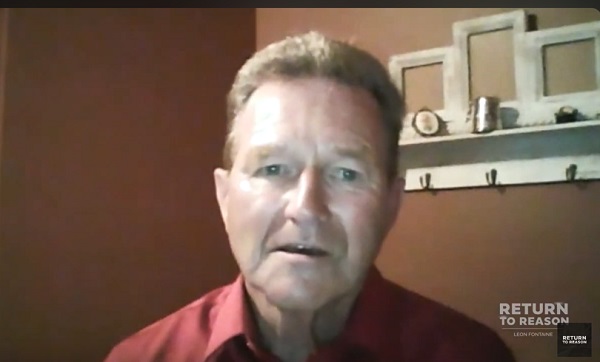National
Retired judge slams Trudeau gov’t for promoting ‘false’ accusation about residential school deaths

Retired Manitoba judge Brian Giesbrecht
From LifeSiteNews
Retired Manitoba judge Brian Giesbrecht observed that allegations were made with ‘no real evidence’ and that reports ‘that thousands of indigenous children had died at residential schools under suspicious circumstances’ are patently ‘false.’
A retired Canadian judge blasted what he said is a “conspiracy theory” lie and “shocking” yet unproven “accusation” being pushed by the Liberal federal government of Prime Minister Justin Trudeau and legacy media that thousands of Indigenous residential school kids died due to negligence by the Catholic priests and nuns.
“The Truth and Reconciliation Commission (TRC) accused Canadian priests, nuns, teachers, and staff at residential schools of somehow being responsible for the disappearance of thousands of indigenous children who attended the schools. That is a shocking accusation,” retired Manitoba judge Brian Giesbrecht wrote in a commentary piece published in the Western Standard last week.
“But it is even more shocking that the accusation was made with no real evidence to support it.”
Giesbrecht observed that reports from TRC commissioners that “that thousands of indigenous children had died at residential schools under suspicious circumstances” are patently “false.”
“Those allegations were false, and based on a conspiracy theory,” Giesbrecht said.
The judge lamented the fact that hundreds of Christian (mostly Catholic) churches have been burned to the ground since the first TRC report came out in 2010, with more than 100 being reduced to ashes since 2021.
In 2021 and 2022, the mainstream media and federal government ran with inflammatory and dubious claims that hundreds of children were buried and disregarded by Catholic priests and nuns who ran some of the schools.
The Tk’emlups te Secwepemc First Nation was more or less the reason there was a large international outcry in 2021 when it claimed it had found 215 “unmarked graves” of kids at the Kamloops Residential School. The claims of remains, however, were not backed by physical evidence but were rather disturbances in the soil picked up by ground-penetrating radar.
The First Nation now has changed its claim of 215 graves to 200 “potential burials.”
Giesbrecht wrote that the fires “increased significantly after the May 27, 2021, Kamloops announcement ramped up that claim to an actual accusation by the Tk’emlups Indian band that 215 children had died under sinister circumstances and were buried by priests in secrecy on the school grounds.
“Where did that Tk’emlups story come from? Most importantly, why would anyone believe such obvious nonsense?” he wrote.
According to Giesbrecht, the “conspiracy theory that launched the entire missing children claim” came from a “largely created” claim by defrocked United Church minister Kevin Annett.
“For reasons that defy rational explanation this unusual man made it his life’s work to take the alcoholic ramblings of a few Vancouvers east side street residents, polish them up, and present them as fact to the world,” the retired justice wrote.
Giesbrecht gave an example of how Annett repeated the story that “Queen Elizabeth had kidnapped 10 children from the Kamloops school, and those children were never seen again,” but was later exposed by an investigative reporter.
According to Giesbrecht, Annett “repeated stories about priests clubbing students to death and throwing them into graves dug by other students, dead boys hanging on meat hooks in barns, and babies thrown into furnaces by priests and nuns.”
“Respected investigative reporter Terry Glavin exposed Annett as a crank and debunked Annett’s wild stories in detail in a 2008 Tyee article. Annett’s stories are so obviously fake that it seems incredible that anyone believed them,” he said.
Giesbrecht noted that it is “hard” to believe that anyone thought the defrocked pastor’s tales were true, but the truth is, people “did” fall for it.
“In fact, some of the people who fell for these stories occupied important positions. One was Gary Merasty, a Member of Parliament. Merasty became so convinced that these claims, as presented in Kevin Annett’s most famous documentary, ‘Unrepentant’ were true, that he was able to convince the Assembly of First Nations (AFN) and other important politicians that the newly appointed TRC commissioners must investigate Annett’s claims,” he said.
According to Giesbrecht, the newly appointed TRC commissioners had “unwisely accepted this new area of study, despite the fact that they had no mandate to do so.”
“When the federal government refused their request for a mandate and funds to search for these phantom ‘missing children’ they ignored the rebuff, and pursued the subject anyway,” he wrote.
“It appears from their statements on the subject that they completely bought into the Annett conspiracy theory. Commissioner Murray Sinclair gave many interviews about these supposedly “missing children” and hinted frequently that dark forces were at play.
LifeSiteNews reported last week that Leah Gazan, backbencher MP from the New Democratic Party, brought forth a new bill that seeks to criminalize the denial of the unproven claim that the residential school system once operating in Canada was a “genocide.”
Media and Trudeau feds worked together to create unproven claims, says judge
Giesbrecht observed that the mainstream media, meanwhile, did not “question any of these always improbable claims,” and “quite the contrary, they not only played along with these baseless claims, but actively encouraged them.”
“It did not seem to occur to them that they were actively supporting a conspiracy theory,” he noted.
The retired judge noted that “Trudeau and his ministers,” notably Marc Miller, “made matters immeasurably worse by immediately ordering all federal flags to be flown at half mast and promising enormous amounts of money to any other indigenous community that wanted to make a similar claim.”
“The truth is that the TRC’s missing children wild goose chase had thoroughly captivated journalists and entire indigenous communities to the extent that the baseless Tk’emlups claim seemed to make sense to them. Justin Trudeau and his ministers were in that gaggle of gullibles. Canada became the laughing stock of the world for dumbly accepting these wild claims,” he wrote.
Giesbrecht observed how since the unfounded claims exploded on the Canadian media and political scene, both the “Trudeau government” and the state-funded “CBC have doubled down on their refusal to correct the misinformation that they have promoted.”
He warned that the next “logical step” for the Trudeau Liberals and mainstream media “is to stop Canadians from even knowing about” the truth of residential schools, as well as for those who have been muzzled or speaking out.
LifeSiteNews reported in August that Trudeau’s cabinet said it will expand a multimillion-dollar fund geared toward documenting claims that hundreds of young children died and were clandestinely buried at now-closed residential schools, some of them run by the Catholic Church.
Canadian indigenous residential schools, run by the Catholic Church and other Christian churches, were set up by the federal government and were open from the late 19th century until 1996.
While there were indeed some Catholics who committed serious abuses against native children, the unproved “mass graves” narrative has led to widespread anti-Catholic sentiment since 2021.
Conservative Party of Canada (CPC) MP Jamil Jivani has urged support from his political opponents for a bill that would give stiffer penalties to arsonists caught burning churches down, saying the recent rash of destruction is a “very serious issue” that is a direct “attack” on families as well as “religious freedom in Canada.”
MacDonald Laurier Institute
Rushing to death in Canada’s MAiD regime

 By Ramona Coelho for Inside Policy
By Ramona Coelho for Inside Policy
Canada legalized Medical Assistance in Dying (MAiD) in 2016, encompassing both euthanasia and assisted suicide. Initially limited to those nearing their natural death, eligibility expanded in 2021 to individuals with physical disabilities, with eligibility for individuals with mental illness in 2027. Parliamentary recommendations include MAiD for children. A recent federal consultation explored extending MAiD to those who lack capacity via advance directives, an approach Quebec has already adopted, despite its criminal status under federal law.
Despite its compassionate framing, investigative journalists and government reports reveal troubling patterns where inadequate exploration of reversible suffering – such as lack of access to medical treatments, poverty, loneliness, and feelings of being a burden – have driven Canadians to choose death. As described by our former Disability Inclusion Minister, Canada’s system at times makes it easier to access MAiD than to receive basic care like a wheelchair. With over 60,000 MAiD cases by the end of 2023, the evidence raises grave concerns about Canada’s MAiD regime.
I am a member of Ontario’s MAiD Death Review Committee (MDRC). Last year, the Chief Coroner released MDRC reports, and a new set of reports has just been published. The first report released by the Office of the Chief Coroner, Waivers of Final Consent, examines how individuals in Track 1 (reasonably foreseeable natural death) can sign waivers to have their lives ended even if they lose the capacity to consent by the scheduled date of MAiD. The second, Navigating Complex Issues within Same Day and Next Day MAiD Provisions, includes cases where MAiD was provided on the same day or the day after it was requested. These reports raise questions about whether proper assessments, thorough exploration of suffering, and informed consent were consistently practised by MAiD clinicians. While MDRC members hold diverse views, here is my take.
Rushing to death, Ignoring Reversible Causes of Suffering
In the same-day or next-day MAiD report, Mrs. B, in her 80s, after complications from surgery, opted for palliative care, leading to discharge home. She later requested a MAiD assessment, but her assessor noted she preferred palliative care based on personal and religious values. The next day, her spouse, struggling with caregiver burnout, took her to the emergency department, but she was discharged home. When a request for hospice palliative care was denied, her spouse contacted the provincial MAiD coordination service for an urgent assessment. A new assessor deemed her eligible for MAiD, despite concerns from the first practitioner, who questioned the new assessor on the urgency, the sudden shift in patient perspective, and the influence of caregiver burnout. The initial assessor requested an opportunity for re-evaluation, but this was denied, with the second assessor deeming it urgent. That evening, a third MAiD practitioner was brought in, and Mrs. B underwent MAiD that night.
The focus should have been on ensuring adequate palliative care and support for Mrs. B and her spouse. Hospice and palliative care teams should have been urgently re-engaged, given the severity of the situation. Additionally, the MAiD provider expedited the process despite the first assessor’s and Mrs. B’s concerns without fully considering the impact of her spouse’s burnout.
The report also has worrying trends suggesting that local medical cultures—rather than patient choice—could be influencing rushed MAiD. Geographic clustering, particularly in Western Ontario, where same-day and next-day MAiD deaths occur most frequently, raises concerns that some MAiD providers may be predisposed to rapidly approve patients for quick death rather than ensuring patients have access to adequate care or exploring if suffering is remediable. This highlights a worrying trend where the speed of the MAiD provision is prioritized over patient-centered care and ethical safeguards.
MAiD without Free and Informed Choice
Consent has been central to Canadians’ acceptance of the legalization of euthanasia and assisted suicide. However, some cases in these reports point to concerns already raised by clinicians: the lack of thorough capacity assessments and concerns that individuals may not have freely chosen MAiD.
In the waiver of final consent report, Mr. B, a man with Alzheimer’s, had been approved for MAiD with such a waiver. However, by the scheduled provision date, his spouse reported increased confusion. Upon arrival, the MAiD provider noted that Mr. B no longer recognized them and so chose not to engage him in discussion at all. Without any verbal interaction to determine his current wishes or understanding, Mr. B’s life was ended.
In the same-day or next-day MAiD report, Mr. C, diagnosed with metastatic cancer, initially expressed interest in MAiD but then experienced cognitive decline and became delirious. He was sedated for pain management. Despite the treating team confirming that capacity was no longer present, a MAiD practitioner arrived and withheld sedation, attempting to rouse him. It was documented that the patient mouthed “yes” and nodded and blinked in response to questions. Based on this interaction, the MAiD provider deemed the patient to have capacity. The MAiD practitioner then facilitated a virtual second assessment, and MAiD was administered.
These individuals were not given genuine opportunities to confirm whether they wished to die. Instead, their past wishes or inquiries were prioritized, raising concerns about ensuring free and informed consent for MAiD. As early as 2020, the Chief Coroner of Ontario identified cases where patients received MAiD without well-documented capacity assessments, even though their medical records suggested they lacked capacity. Further, when Dr. Leonie Herx, past president of the Canadian Society of Palliative Medicine, testified before Parliament about MAiD frequently occurring without capacity, an MP dismissed her, advising Parliament to be cautious about considering seriously evidence under parliamentary immunities that amounted to malpractice allegations, which should be handled by the appropriate regulatory bodies or police. These dismissive comments stand in stark contrast with the gravity of assessing financial capacity, and yet the magnitude is greater when ending life. By way of comparison, for my father, an Ontario-approved capacity expert conducted a rigorous evaluation before declaring him incapable of managing his finances. This included a lengthy interview, collateral history, and review of financial documents—yet no such rigorous capacity assessment is mandated for MAiD.
What is Compassion?
While the federal government has finished its consultation on advance directives for MAiD, experts warn against overlooking the complexities of choosing death based on hypothetical suffering and no lived experience to inform those choices. A substitute decision-maker has to interpret prior wishes, leading to guesswork and ethical dilemmas. These cases highlight how vulnerable individuals, having lost the capacity to consent, may be coerced or unduly influenced to die—whether through financial abuse, caregiver burnout, or other pressures—reminding us that the stakes are high – life and death, no less.
The fundamental expectation of health care should be to rush to care for the patient, providing support through a system that embraces them—not rush them toward death without efforts to mitigate suffering or ensure free and informed consent. If we truly value dignity, we must invest in comprehensive care to prevent patients from being administered speedy death in their most vulnerable moment, turning their worst day into potentially their last.
Dr. Ramona Coelho is a family physician whose practice largely serves marginalised persons in London, Ontario. She is a senior fellow at the Macdonald-Laurier Institute and co-editor of the new book “Unravelling MAiD in Canada” from McGill University Press.
International
UN committee urges Canada to repeal euthanasia for non-terminally ill patients

From LifeSiteNews
The UN Committee on the Rights of Persons with Disabilities has warned against Canada’s euthanasia program, urging the repeal of legislation that allows the killing of non-terminally ill individuals.
Canada’s euthanasia regime has become too radical even for the anti-life United Nations, who recently called on the nation to repeal its law allowing non-terminally ill patients to qualify for death through the state’s “Medical Assistance in Dying” program.
In closing remarks published March 21, the UN Committee on the Rights of Persons with Disabilities argued that Canada should repeal its 2021 MAID expansion legislation that allowed those who are chronically ill but not terminally ill to be put to death by the state.
The committee said that Canada’s regime “establishes medically assisted dying for persons with disabilities based on negative, ableist perceptions of the quality and value of the life of persons with disabilities, including that ‘suffering’ is intrinsic to disability rather than the fact that inequality and discrimination cause and compound ‘suffering’ for persons with disabilities.”
It pointed out that “the concept of ‘choice’ creates a false dichotomy by setting up the premise that if persons with disabilities are suffering, it is valid for the State Party to enable their death.”
In Canada, euthanasia is divided into Track 1 and Track 2 requests. Track 1 requests deal with those whose death is allegedly imminent or foreseeable. Track 2 requests deal with those who are not terminally ill but have lost the will to live due to their having chronic health problems.
The UN committee took specific issue with Track 2 MAID, writing that it is “extremely concerned about the 2021 amendments to the State Party’s Criminal Code through Bill C-7 that expanded the eligibility criteria for obtaining Medical Assistance in Dying (MAID), known as ‘Track 2’ MAiD by removing the ‘foreseeable death’ criteria.”
The committee further recommended that Canada not euthanize its citizens for mental health reasons and abandon additional expansions of the program. Such an expansion is slated to come into effect in 2027.
It is worth noting that while Track 2 cases of MAID are indeed evil, so are Track 1 cases. The Catholic Church infallibly teaches that euthanasia is a grave evil tantamount to murder and must be rejected in all circumstances.
The UN committee’s criticism of Canada’s euthanasia regime comes after many have pointed out that the regime has spawned a culture of death and eugenics in the country, with the disabled and the poor often being those who request or who are even suggested to request death via Track 2 MAID.
In one case, a Nova Scotia grandmother revealed that doctors repeatedly offered her euthanasia while she underwent cancer treatment, making her feel as though she was “better off dead.”
“I felt like a problem that needed to be [gotten] rid of instead of a patient in need of treatment,” she said. “I don’t want to be asked if I want to die.”
Similarly, in May of last year, LifeSiteNews reported on a Canadian man who felt “completely traumatized” and violated that he was offered MAID “multiple times” instead of getting the proper care he needed while in the hospital.
The most recent reports show that MAID is the sixth highest cause of death in Canada. However, it was not listed as such in Statistics Canada’s top 10 leading causes of death from 2019 to 2022.
When asked why MIiD was left off the list, the agency said that it records the illnesses that led Canadians to choose to end their lives via euthanasia, not the actual cause of death, as the primary cause of death.
According to Health Canada, in 2022, 13,241 Canadians died by MAID lethal injections. This accounts for 4.1 percent of all deaths in the country for that year, a 31.2 percent increase from 2021.
-

 2025 Federal Election1 day ago
2025 Federal Election1 day agoLiberals Replace Candidate Embroiled in Election Interference Scandal with Board Member of School Flagged in Canada’s Election Interference Inquiry
-

 espionage2 days ago
espionage2 days agoU.S. Experts Warn Canada Is Losing the Fight Against PRC Criminal Networks—Washington Has Run Out of Patience
-

 Automotive2 days ago
Automotive2 days agoTesla Vandals Keep Running Into The Same Problem … Cameras
-

 Business9 hours ago
Business9 hours agoTrump threatens additional 50% tariffs on China, urges ‘patience’
-

 Alberta9 hours ago
Alberta9 hours agoProvince introducing “Patient-Focused Funding Model” to fund acute care in Alberta
-

 Business22 hours ago
Business22 hours agoJury verdict against oil industry worries critics, could drive up energy costs
-

 Alberta1 day ago
Alberta1 day agoIs Canada’s Federation Fair?
-

 MacDonald Laurier Institute7 hours ago
MacDonald Laurier Institute7 hours agoRushing to death in Canada’s MAiD regime




